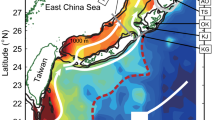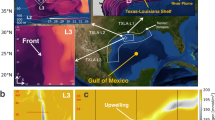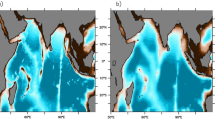Abstract
Cold-core (T < 0 °C) domes of dense water σθ > 27.24 kg/m3 were observed in the near-bottom layer at the shelf break in Peter the Great Bay (PGB) of the Japan/East Sea in March 2010. The anomalously cold water was 0.4 ml/l richer in oxygen than was the surrounding water, and it contained more suspended particles. The observations were carried out by using a moored automatic mobile Aqualog profiler. Profiling occurred as frequent as every hour, allowing us to obtain data with high temporal resolution. The Aqualog profiler delivered vertical profiles of the ocean current velocity, acoustic backscatter at 2 MHz, temperature, and salinity between the depths of 20 and 105 m. Other oceanographic instruments were mounted at fixed depths on the mooring line to measure current velocity, temperature, conductivity, dissolved oxygen, chlorophyll-a fluorescence, and turbidity. Complementary data included ship-borne CTD casts and satellite-borne imagery and scatterometry as well as coastal weather station records. The Regional Ocean Modeling System (ROMS) was employed to study the origin and evolution of the cold water. The model simulated the ocean dynamics at a 600-m horizontal resolution in PGB from 2009 to 2010. The model was forced by the surface momentum, heat and fresh water fluxes of the NCEP-DOE Reanalysis 2. The lateral boundary condition of the model was obtained from nesting into a Japan Coastal Ocean Predictability Experiment model data set. According to the ROMS simulation, the circulation in Ussuri Bay in the northeastern bay of PGB was anticyclonic in February–March 2010. The submesoscale cyclonic vortices generated around the anticyclonic gyre. The submesoscale cyclones tended to move southward out of the bay, and they transported the anomalously cold water towards the outer shelf. As a result, the cold water anomalies were often observed to persist for as long as 2 days near 42.5°N, 132°E. Lagrangian analysis confirmed that this cold water observed by the Aqualog profiler originated in Ussuri Bay. The model simulation showed that the submesoscale cyclonic eddies played a specific role in supplying the densest water from the northern part of PGB to the outer shelf, where the dense water was then entrained by the mesoscale eddies in the Primorye Current zone and could cascade down the continental slope into the deep northern basin of the sea. This transport of the densest water by the submesoscale eddies was estimated to be 5–10·10−3 Sv in February–March 2010.



















Similar content being viewed by others
References
Bentamy A, Croize-Fillon DC (2011) Gridded surface wind fields from Metop/ASCAT measure-ments. Int J Remote Sens 33:1729–1754. https://doi.org/10.1080/01431161.2011.600348
Budyansky MV, Ponomarev V I, Fyman PA, Uleysky M Yu, Prants S V (2011) Lagrangian approach to chaotic transport and mixing in the Japan Sea. Chaos theory: modeling, simulation and applications. Selected papers from the 3rd Chaotic Modeling and Simulation International Conference (CHAOS2010). Singapore: World Scientific, 3–13. https://doi.org/10.1142/9789814350341_0001
Bugaets AN, Gartsman BI, Krasnopeev SA, Bugaets ND (2013) An experience of updated hydrological network data processing using the CUAHSI HIS ODM data management system. Russ Meteorol Hydrol 38:359–366. https://doi.org/10.3103/S1068373913050099
Bunimovich LA, Ostrovskii AG, Umatani S (1993) Observations of the fractal properties of the Japan Sea surface temperature patterns. Int J Remote Sens 14:2185–2201. https://doi.org/10.1080/01431169308954028
Donlon C J, Martin M, Stark J D, Roberts-Jones J, Fiedler E, Wimmer W (2011) The operational sea surface temperature and sea ice analysis (OSTIA). Remote Sensing of Enviroment Special Issue on (A)ATSR. https://doi.org/10.1016/j.rse.2010.10.017
Dubina VA, Mitnik LM, Katin IO (2008) Peculiarities of water circulation in Peter the Great Bay based on satellite multisensory data. In: Akulichev VA (ed) Modern state and tendency of variability of the Peter the Great Bay environment. GEOS, Moscow, pp 82–96 (in Russian)
Dubina VA, Fayman PA, Ponomarev VI (2013) Vortex structure of currents in Peter the Great Bay. Izvestiya TINRO 173:247–258 (in Russian)
Durrieu de Madron X, Houpert L, Puig P, Sanchez-Vidal A, Testor P, Bosse A, Estournel C, Somot S, Bourrin F, Bouin MN, Beauverger M, Beguery L, Calafat A, Canals M, Cassou C, Coppola L, Dausse D, D'Ortenzio F, Font J, Heussner S, Kunesch S, Lefevre D, le Goff H, Martín J, Mortier L, Palanques A, Raimbault P (2013) Interaction of dense shelf water cascading and open-sea convection in the northwestern Mediterranean during winter 2012. Geophys Res Lett 40:1379–1385. https://doi.org/10.1002/grl.50331
Fairall CW, Bradley EF, Rogers DP, Edson JB, Young GS (1996) Bulk parameterization of air-sea fluxes for tropical ocean-global atmosphere Coupled-Ocean atmosphere response experiment. J Geophys Res 101:3747–3764. https://doi.org/10.1029/95JC03205
Fayman PA (2003) The currents modeling for Peter the Great Bay on the base of FERHRI survey, 2001. Pacific Oceanogr 1:79–81
Fayman PA, Ponomarev VI (2008) Diagnostic simulation of sea currents in the Peter the Great Bay based on FERHRI oceanographic surveys. Pacific Oceanogr 4:56–64
Kanamitsu M, Ebisuzaki W, Woollen J, Yang SK, Hnilo JJ, Fiorinoand M, Potter GL (2002) NCEP-DEO AMIP-II reanalysis (R-2). Bull Am Meteorol Soc 83:1631–1643. https://doi.org/10.1175/BAMS-83-11-1631
Kawamura H, Wu P (1998) Formation mechanism of Japan Sea proper water in the flux center off Vladivostok. J Geophys Res 103:21611–21622. https://doi.org/10.1029/98JC01948
Kim K-R, Kim G, Kim K, Lobanov L, Ponomarev V, Salyuk A (2002) A sudden bottom-water formation during the severe winter 2000–2001: the case of the East/Japan Sea. Geophys Res Lett 29(8):75-1–75-4. https://doi.org/10.1029/2001GL014498
Ladychenko SY, Lobanov VB (2013) Mesoscale eddies in the area of Peter the Great Bay according to satellite data. Izvestiya, Atmos Oceanic Phys 49:939–951. https://doi.org/10.1134/S0001433813090193
Lobanov V, Salyuk A, Ponomarev V, Talley L, Kim K, Kim K-R, Tishchenko P, Nedashkovskiy A, Kim G-B, Sagalaev S (2002) Renewal of bottom water in the Japan/East Sea. In: Proceedings 17th International Symposium on Okhotsk Sea & Sea Ice, 24–28 February, 2002, Japan, Mombetsu, pp 31–36
Lobanov VB, Ponomarev VI, Salyuk AN, Tishchenko PY, Talley LD (2007) Structure and dynamics of synoptic scale eddies in the northern Japan Sea. In: Far eastern seas of Russia. V. 1. Oceanographic research. Nauka, Moscow, pp 450–473 (in Russian)
Lobanov V, Sergeev A, Gorin I, Shcherbinin P, Voronin A, Kaplunenko D, Popov O, Gulenko T (2014) Observations of dense water cascading along the Peter the Great Bay slope in the northwestern Japan Sea. In: Yu D, Chashechkin, Baydulov VG (Eds.) International Conference on Fluxes and Structures in Fluids, Selected Papers. Moscow: MAKS Press, pp. 142–150
Miyazawa Y, Zhang R, Guo X, Tamura H, Ambe D, Lee J-S, Okuno A, Yoshinari H, Setou T, Komatsu K (2009) Water mass variability in the western North Pacific detected in a 15-year eddy resolving ocean reanalysis. J Oceanogr 65:737–756. https://doi.org/10.1007/s10872-009-0063-3
Nikitin AA, Lobanov VB, Danchenkov MA (2002) Possible pathways of the transport of warm subtropical waters into the area of the Far East Marine Reserve. Izvestiya TINRO 131:41–53 (in Russian)
Ostrovskii AG (1995) Signatures of stirring and mixing in the Japan Sea surface temperature patterns in autumn 1993 and spring 1994. Geophys Res Lett 22:2357–2360. https://doi.org/10.1029/95GL02494
Ostrovskii AG, Zatsepin AG (2011) Short-term hydrophysical and biological variability over the northeastern Black Sea continental slope as inferred from multiparametric tethered profiler surveys. Ocean Dyn 61:797–806. https://doi.org/10.1007/s10236-011-0400-0
Ostrovskii AG, Zatsepin AG, Soloviev VA, Tsibulsky AL, Shvoev DA (2013) Autonomous system for vertical profiling of the marine environment at a moored station. Oceanology 53:233–242. https://doi.org/10.1134/S0001437013020124
Park JJ, Lim B (2018) A new perspective on origin of the East Sea intermediate water: observations of Argo floats. Prog Oceanogr 160:213–224. https://doi.org/10.1016/j.pocean.2017.10.015
Prants SV, Budyansky MV, Ponomarev VI, Uleysky MY (2011) Lagrangian study of transport and mixing in a mesoscale eddy street. Ocean Model 38:114–125. https://doi.org/10.1016/j.ocemod.2011.02.008
Prants SV, Ponomarev VI, Budyansky MV, Uleysky MY, Fayman PA (2013) Lagrangian analysis of mixing and transport of water masses in the marine bays. Izvestiya Atmos Oceanic Phys 49:82–96. https://doi.org/10.1134/S0001433813010088
Rogachev K (2013) Dynamics of anticyclonic eddies and rapid ventilation of bottom waters in the Ussury Bay, Sea of Japan. Earth Research from Space. 2:42–49. https://doi.org/10.7868/S0205961413020103
Sasaki H, Klein P, Qiu B, Sasai Y (2014) Impact of oceanic-scale interactions on the seasonal modulation of ocean dynamics by the atmosphere. Nat Commun 5(5636):5636. https://doi.org/10.1038/ncomms6636
Savelieva N.I. (1989) General circulation in the Amur and Ussuri Bays based on the numerical model simulation. Far-Eastern Branch of the USSR Academy of Sciences Publishin House, Vladivostok, 29 p. (in Russian)
Senjyu T (1999) The Japan Sea intermediate water; its characteristics and circulation. J Oceanogr 55:111–122. https://doi.org/10.1023/A:1007825609622
Senjyu T, Aramaki T, Otosaka S, Togawa O, Danchenkov M, Karasev E, Volkov Y (2002) Renewal of the bottom water after the winter 2000–2001 may spin-up the thermohaline circulation in the Japan Sea. Geophys Res Lett 29(1149). https://doi.org/10.1029/2001GL014093
Seung Y-H, Yoon J-H (1995) Some features of winter convection in the Japan Sea. J Oceanogr 51:61–73. https://doi.org/10.1007/BF02235936
Shchepetkin AF, McWilliams JC (2003) A method for computing horizontal pressure-gradient force in an oceanic model with a nonaligned vertical coordinate. J Geophys Res 108(C3):3090. https://doi.org/10.1029/2001JC001047
Shchepetkin AF, McWilliams JC (2005) The regional ocean modeling system: a split-explicit, free-surface, topography following coordinates ocean model. Ocean Model 9:347–404. https://doi.org/10.1016/j.ocemod.2004.08.002
Su Z, Ingersoll AP, Stewart AL, Thompson AF (2016a) Ocean convective available potential energy. Part I: concept and calculation. J Phys Oceanogr 46:1081–1096. https://doi.org/10.1175/JPO-D-14-0155.1
Su Z, Ingersoll AP, Stewart AL, Thompson AF (2016b) Ocean convective available potential energy. Part II: energetics of thermobaric convection and thermobaric cabbeling. J Phys Oceanogr 46:1097–1115. https://doi.org/10.1175/JPO-D-14-0156.1
Su Z, Wang J, Klein P, Thompson AF, Menemenlis D (2018) Ocean submesoscales as a key component of the global heat budget. Nat Commun 9:775. https://doi.org/10.1038/s41467-018-02983-w
Talley LD, Lobanov V, Ponomarev V, Salyuk A, Tishchenko P, Zhabin I, Riser S (2003) Deep convection and brine rejection in the Japan Sea. Geophys Res Lett 30(1159). https://doi.org/10.1029/2002GL016451
Talley LD, Min D-H, Lobanov V, Luchin V, Ponomarev V, Salyuk A, Shcherbina AY, Tishchenko PY, Zhabin I (2006) East/Japan Sea water masses and their relation to the Sea's circulation. Oceanogr 19:32–49. https://doi.org/10.5670/oceanog.2006.42
Torres HS, Klein P, Menemenlis D, Qiu B, Su Z, Wang J, Chen S, Fu L-L (2018) Partitioning Ocean motions into balanced motions and internal gravity waves: a modeling study in anticipation of future space missions. J Geophys Res Oceans 123:8084–8105. https://doi.org/10.1029/2018JC014438
Umlauf L, Burchard H (2003) A generic length-scale equation for geophysical turbulenc models. J Mar Res 61:235–265. https://doi.org/10.1357/002224003322005087
Vasilev A S, Makashin V P (1992) Ventilation of the Japan Sea waters in winter. La Mer 30: 169-177
Voltsinger N E, Piaskovskii R V (1977) Theory of the shallow water. Oceanographic problems and numerical methods. L.: Gidrometeoizdat, 206 p. (in Russian)
Yoon J-H, Abe K, Ogata T, Wakamatsu Y (2005) The effects of wind-stress curl on the Japan/East Sea circulation. Deep-Sea Res II Top Stud Oceanogr 52:1827–1844. https://doi.org/10.1016/j.dsr2.2004.03.004
Yurasov G I, Yarichin V G (1991) Currents in the Japan Sea. Vladivostok, FEB AS USSR, 174 p. (in Russian)
Acknowledgements
The data were collected during field experiment with the moored profiler Aqualog. The experiments were supported by Foundation for Assistance to Small Innovative Enterprises (FASIE), Moscow. We thank Igor Gorin (POI FEB RAS), Sergey Nizov, Valdimir Solovyev, and Dmitry Shvoev (all of SIO RAS) who handled the equipment during the cruises of R/V Professor Gagarinskiy. We are grateful to Dmitry Solovyev (MHI RAS) who processed the satellite imagery data. Support of the crew of R/V Professor Gagarinsky is appreciated. The data analysis for Section 2 was carried out under Agreement between Korea Institute of Ocean Science and Technology (KIOST) and Shirshov Institute of Oceanology Russian Academy of Sciences of December 15, 2015 on the scientific research project entitled Research on the Variability of the Circulation in the Northern East Sea supported by “Development of satellite based ocean carbon flux model for seas around Korea” project funded by Ministry of Ocean and Fisheries, Republic of Korea. The literature review for Section 1 and the data analysis for Section 3 were both supported by using funding of the Russian state basic research task no. 0149-2018-0010. The model simulation and the model data analysis for Sections 4 and 5 was supported by Russian Foundation for Basic Research grants 16-05-00899 and 16-55-50071jf-a and FEB RAS Priority Program “Far East” grant 18-1-010. The ROMS was run at the supercomputer of Shared Resource Center “Far Eastern Computing Resource” IACP FEB RAS (https://cc.dvo.ru).
Author information
Authors and Affiliations
Corresponding author
Additional information
Responsible Editor: Aida Alvera-Azcárate
Electronic supplementary material
ESM 1
(DOC 36 kb)
Rights and permissions
About this article
Cite this article
Fayman, P., Ostrovskii, A., Lobanov, V. et al. Submesoscale eddies in Peter the Great Bay of the Japan/East Sea in winter. Ocean Dynamics 69, 443–462 (2019). https://doi.org/10.1007/s10236-019-01252-8
Received:
Accepted:
Published:
Issue Date:
DOI: https://doi.org/10.1007/s10236-019-01252-8




